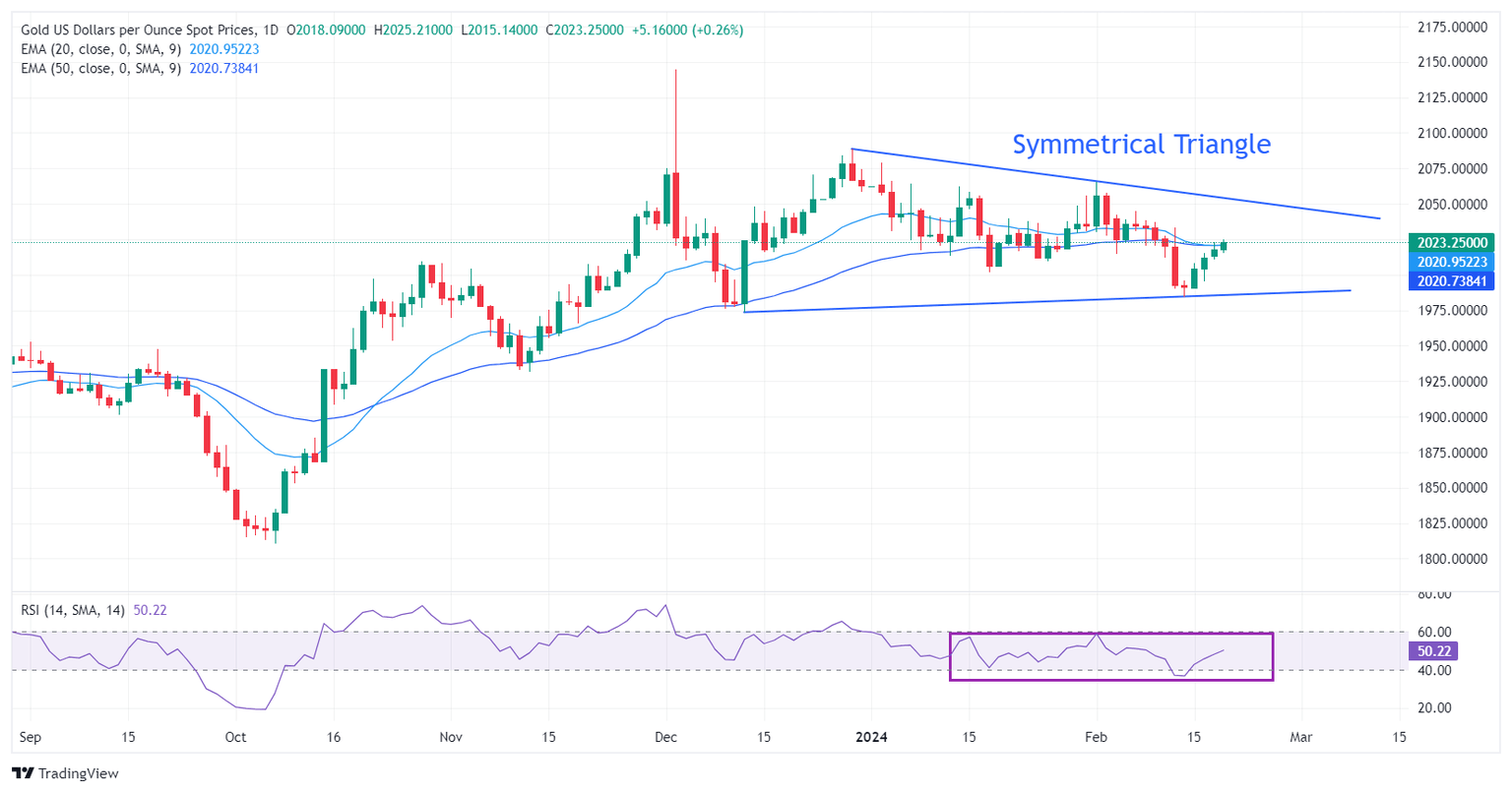Gold price soars as Fed sees inflation declining in long term
- Gold price generates more gains as Fed policymakers are confident that inflation is broadly declining.
- The FOMC minutes for January policy will deeply explain the Fed's steady interest rate decision.
- Investors see the preliminary S&P Global Manufacturing PMI for February at 50.5.

Gold price (XAU/USD) extends its bullish streak for the fourth straight trading session on Tuesday. The outlook for the precious metal has strengthened as commentary from Federal Reserve (Fed) policymakers that inflation is broadly moving in the right direction has faded the impact of stubborn Consumer Price Index (CPI) and Producer Price Index (PPI) data for January.
The confidence of Fed policymakers that inflation is declining over the long term has trimmed the opportunity cost of holding non-yielding assets such as Gold. Meanwhile, investors await the Federal Reserve Open Market Committee (FOMC) minutes for the first monetary policy meeting of 2024. The FOMC minutes will provide cues about the timing of three rate-cuts, as forecasted by the Fed.
On the economic data front, preliminary S&P Global PMI data for February will guide the forward action in the Gold price and the US Dollar, which will be published on Thursday. The US Manufacturing PMI is expected to exceed the 50.0 threshold for the second straight month at 50.5. An upbeat factory data would have a negative impact on the Gold price.
Daily Digest Market Movers: Gold price jumps higher ahead of Fed minutes
- Gold price continues to generate gains and extend the upside above a four-day high of around $2,023.
- The upside in the precious metal seems restricted amid persistent fears of higher for longer interest rates by the Federal Reserve due to stubborn inflation data.
- The United States core inflation data is almost double the required rate of 2%, easing hopes of rate cuts by the Fed before June.
- The CME FedWatch tool shows that traders are confident that interest rates will remain unchanged in the range of 5.25%-5.50% till the May monetary policy meeting. For the June meeting, chances for a 25 basis points (bps) rate cut stand at 53%.
- While investors have significantly lowered their bets for rate cuts after stubborn consumer and producer price inflation data for January, Fed policymakers see the one-time high inflation as insignificant.
- Fed policymakers believe the longer-run inflation trend is declining, and overly focusing on a one-time blip could be a tremendous mistake.
- The US Dollar Index, which measures the value of the Greenback against six major currencies, is confined in a tight range around 104.20 as investors await the FOMC minutes for the January policy meeting, which will be released on Wednesday.
- The FOMC minutes will deeply explain the maintenance of interest rates at their current level for the fourth time in a row.
- In the monetary policy statement, Fed Chair Jerome Powell said a continuation of good data is required to reduce borrowing rates. Good data means easing price pressures.
- Meanwhile, 10-year US Treasury yields, which reflect expectations for Fed policy, are slightly up to near 4.30%.
Technical Analysis: Gold price aims to recapture $2,030
Gold price continues its winning spell for the fourth straight trading session. The precious metal attempts to deliver a decisive break above the 20 and 50-day Exponential Moving Averages (EMAs), which trade around $2,020.
The primary trend in the Gold price indicates indecisiveness among market participants due to a Symmetrical Triangle formation on a daily time frame. The upward and downward-sloping borders of the aforementioned chart pattern are plotted from December 13 low at $1,973 and December 28 high at $2,088, respectively.
The triangle could breakout in either direction, however, the odds marginally favor a move in the direction of the trend before the formation of the triangle – in this case up. A decisive break above or below the triangle boundary lines would indicate a breakout was underway.
The 14-period Relative Strength Index (RSI) has returned to the 40.00-60.00 range quickly after testing territory below 40.00, indicating a strong bullish reversal.
Fed FAQs
What does the Federal Reserve do, how does it impact the US Dollar?
Monetary policy in the US is shaped by the Federal Reserve (Fed). The Fed has two mandates: to achieve price stability and foster full employment. Its primary tool to achieve these goals is by adjusting interest rates.
When prices are rising too quickly and inflation is above the Fed’s 2% target, it raises interest rates, increasing borrowing costs throughout the economy. This results in a stronger US Dollar (USD) as it makes the US a more attractive place for international investors to park their money.
When inflation falls below 2% or the Unemployment Rate is too high, the Fed may lower interest rates to encourage borrowing, which weighs on the Greenback.
How often does the Fed hold monetary policy meetings?
The Federal Reserve (Fed) holds eight policy meetings a year, where the Federal Open Market Committee (FOMC) assesses economic conditions and makes monetary policy decisions.
The FOMC is attended by twelve Fed officials – the seven members of the Board of Governors, the president of the Federal Reserve Bank of New York, and four of the remaining eleven regional Reserve Bank presidents, who serve one-year terms on a rotating basis.
What is Quantitative Easing (QE) and how does it impact USD?
In extreme situations, the Federal Reserve may resort to a policy named Quantitative Easing (QE). QE is the process by which the Fed substantially increases the flow of credit in a stuck financial system.
It is a non-standard policy measure used during crises or when inflation is extremely low. It was the Fed’s weapon of choice during the Great Financial Crisis in 2008. It involves the Fed printing more Dollars and using them to buy high grade bonds from financial institutions. QE usually weakens the US Dollar.
What is Quantitative Tightening (QT) and how does it impact the US Dollar?
Quantitative tightening (QT) is the reverse process of QE, whereby the Federal Reserve stops buying bonds from financial institutions and does not reinvest the principal from the bonds it holds maturing, to purchase new bonds. It is usually positive for the value of the US Dollar.
Author

Sagar Dua
FXStreet
Sagar Dua is associated with the financial markets from his college days. Along with pursuing post-graduation in Commerce in 2014, he started his markets training with chart analysis.


















